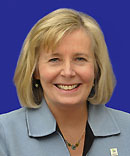Twin Cities regional transitways will spur economic development
May 2011
With construction under way on two major transitways – Central Corridor light rail and Cedar Avenue bus rapid transit – we’re in a remarkable period of progress for transit and future economic development in the Twin Cities metropolitan region. Now is not the time to put on the brakes.

A region cannot hope to compete in the global economy without a flexible, resilient transportation system, and that includes a thriving transit system. The Metropolitan Council has a vision for transit in this region, a vision of a network of dedicated transitways that:
- Enable fast, reliable travel times for transit customers.
- Bypass traffic congestion in heavily traveled corridors.
- Improve the daily commute for all commuters by taking single-occupant vehicles off the highway, thereby slowing the growth of traffic congestion.
- Offer better connections between local bus service and key regional destinations.
The Council’s vision is for improved mobility that enhances economic development. We know that dedicated transitways create magnets for economic development, and that means jobs. The business community supports transit investments because transit brings workers to jobs, future workers to school and customers to their doorstep.
Transit offers people choices. It offers people a choice of how to get to work and where to live. Transit also offers people an important option for reducing their impact on the environment. We know that many workers, especially young, well-educated workers, choose regions that have good transit options.
Our vision is to double annual transit ridership in this region from 2003 levels to 147 million rides by 2030. Transitways like Central Corridor LRT and Cedar Avenue BRT will help this region realize that vision.
It takes many years of planning and commitment on the part of many partners to bring a transitway to fruition. Local officials and community representatives, in particular, work tirelessly to create and implement plans that have broad public buy-in. And our state and federal partners are essential to making transit possible.
Proposals in the Minnesota Legislature would reverse the progress we’ve made in recent years. As the economy improves and gas prices rise, more people, not fewer, will rely on transit. Let’s hold fast to our vision and continue to create the kind of world-class region that will mean a better economy and environment for all of us.
Susan Haigh
May 2011